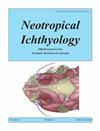黑马氏四虎的早期个体发育(特征:特征科)
IF 2
4区 生物学
Q1 ZOOLOGY
引用次数: 0
摘要
摘要从形态特征、色素沉着和形态计量学等方面描述了黑马歧楠的早期发育。通过半自然繁殖获得幼虫,收集,固定,并根据其发育进行鉴定。对标准体长3.1 ~ 24.3 mm的80个个体进行了分析。幼虫在孵化时发育不良,卵黄囊和鳍鳍相对较大。前屈期,眼睛色素沉着,口、肛门功能正常,卵黄完全吸收,胸鳍芽出现。在弯曲时,尾鳍、肛鳍和背鳍的第一道光线变得明显。除了腹鳍完全吸收外,腹鳍芽仅在屈曲后阶段出现。色素沉着分布于全身,在头顶、嘴周围和尾鳍基部集中较多。肌粒总数为34 ~ 49个(肛门前16 ~ 23个,肛门后18 ~ 27个)。幼鱼的形态特征与成虫相似。鳍条数为胸鳍11-13条,骨盆鳍5-7条,背鳍8-11条,尾鳍16-27条,肛门鳍30-47条。形态计量学关系揭示了沿物种早期个体发育的生长变化。本文章由计算机程序翻译,如有差异,请以英文原文为准。
Early ontogeny of tetra Markiana nigripinnis (Characiformes: Characidae)
Abstract The early development of Markiana nigripinnis is described by morphological characters, pigmentation, and morphometry. Larvae were obtained through semi-natural breeding, collected, fixed, and identified according to their development. Eighty individuals with standard lengths ranging from 3.1 to 24.3 mm were analyzed. Larvae are poorly developed at hatching, with a relatively large yolk sac and finfold. At the preflexion stage, the eyes are pigmented, the mouth and anus are functional, the yolk is completely absorbed, and the pectoral fin bud emerges. At flexion, the first rays of the caudal, anal, and dorsal fins become evident. The pelvic fin bud emerges only at the postflexion stage, in addition to the complete absorption of the finfold. Pigmentation is distributed throughout the body, with a greater concentration on the top of the head, around the mouth, and at the base of the caudal fin. The myomere total number ranged from 34 to 49 (16–23 preanal, and 18–27 postanal). Juveniles show morphological characteristics like adults. The fins ray number are pectoral: 11–13, pelvic: 5–7, dorsal: 8–11, caudal: 16–27, and anal 30–47. The morphometric relationships reveal variations in growth along the early ontogeny of the species.
求助全文
通过发布文献求助,成功后即可免费获取论文全文。
去求助
来源期刊

Neotropical Ichthyology
生物-动物学
CiteScore
2.80
自引率
17.60%
发文量
24
审稿时长
6-12 weeks
期刊介绍:
Neotropical Ichthyology is the official journal of the Sociedade Brasileira de Ictiologia (SBI). It is an international peer-reviewed Open Access periodical that publishes original articles and reviews exclusively on Neotropical freshwater and marine fishes and constitutes an International Forum to disclose and discuss results of original research on the diversity of marine, estuarine and freshwater Neotropical fishes.
-Frequency: Four issues per year published only online since 2020, using the ‘rolling pass’ system, which posts articles online immediately as soon as they are ready for publication. A searchable and citable Digital Object Identifier (DOI) is assigned to each article immediately after online publication, with no need to await the issue’s closing.
-Areas of interest: Biology, Biochemistry and Physiology, Ecology, Ethology, Genetics and Molecular Biology, Systematics.
-Peer review process: The Editor-in-Chief screens each manuscript submitted to Neotropical Ichthyology to verify whether it is within the journal’s scope and policy, presents original research and follows the journal’s guidelines. After passing through the initial screening, articles are assigned to a Section Editor, who then assigns an Associate Editor to start the single blind review process.
 求助内容:
求助内容: 应助结果提醒方式:
应助结果提醒方式:


